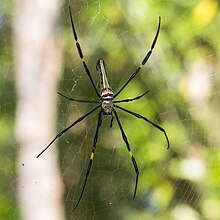Nephila pilipes
| Nephila pilipes | |
|---|---|
 |
|
| Dorsal side Bantul, Indonesia |
|
 |
|
| Ventral side Bali, Indonesia |
|
| Scientific classification | |
| Kingdom: | Animalia |
| Phylum: | Arthropoda |
| Class: | Arachnida |
| Order: | Araneae |
| Suborder: | Araneomorphae |
| Family: | Nephilidae |
| Genus: | Nephila |
| Species: | N. pilipes |
| Binomial name | |
|
Nephila pilipes (Fabricius, 1793) |
|
| Synonyms | |
|
Aranea longipes |
|
Aranea longipes
Aranea maculata
Aranea pilipes
Aranea sebae
Epeira chrysogaster
Nephila maculata
Nephila fuscipes
Epeira fuscipes
Epeira doreyana
Epeira caliginosa
Nephila ornata
Epeira penicillum
Epeira harpyia
Nephila chrysogaster
Meta ornata
Nephila pecuniosa
Nephila aurosa
Nephila procera
Nephila sulphurosa
Nephila tenuipes
Nephila submaculata
Nephila pilipes (northern golden orb weaver or giant golden orb weaver) is a species of golden orb-web spider. It can be found in Japan, China, Vietnam, Cambodia, Taiwan, Malaysia, Singapore, Myanmar, Indonesia, Thailand, Laos, Philippines, Sri Lanka, India, and Papua New Guinea. It is commonly found in primary and secondary forests and gardens. Females are large and grow to a body size of 30–50 mm (overall size up to 20 cm), with males growing to 5–6 mm. It is one of the biggest spiders in the world.
The Nephila pilipes' golden web is vertical with a fine irregular mesh and not symmetrical, with the hub usually nearer the top. Rather than egg sacks being hung in the web, a pit is dug which is then covered with plant debris or soil.
The first, second and fourth pairs of legs of juvenile females have dense hairy brushes, but as the spider matures these brushes disappear.
Nephila pilipes display sexual dimorphism, the presence of distinct difference between the males and females of a species. In Nephila pilipes female spiders are much larger than their male counterparts, and males can be 4-10 times smaller than the females.
Sexual dimorphism appears to be a shared feature among Nephila pilipes spiders of different populations, as examinations of populations in Southeast Asia, Australia, and Papua New Guinea show similar patterns of size dimorphism. Two major hypotheses have been suggested to explain this sexual selection and they are female gigantism and male dwarfism.
...
Wikipedia
